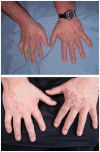Altered manifestations of skin disease at sites affected by neurological deficit - PubMed (original) (raw)
Review
. 2015 Apr;172(4):988-93.
doi: 10.1111/bjd.13352. Epub 2015 Feb 25.
Affiliations
- PMID: 25132518
- PMCID: PMC4326606
- DOI: 10.1111/bjd.13352
Review
Altered manifestations of skin disease at sites affected by neurological deficit
E Azimi et al. Br J Dermatol. 2015 Apr.
Abstract
Background: The contribution of the nervous system to inflammation in general and inflammatory skin disease in particular has been underappreciated. It is now apparent that an intact neural component is required for the conventional clinical manifestations of many inflammatory skin diseases.
Objectives: To investigate the relationship between nerve damage and skin disease.
Methods: Previous individual reports since 1966 were collected systematically and the clinical observations described therein were placed within current concepts of neurogenic inflammation.
Results: We reviewed the literature and identified 23 cases of alterations in the appearance or distribution of skin disorders in patients with acquired central or peripheral neural damage or dysfunction. In 19 cases, near or complete resolution of pre-existing skin lesions occurred in areas directly or indirectly supplied by a subsequently injured nervous system. Exacerbation or new onset of skin lesions occurred in only four cases. The neural deficits described included damage within the peripheral or central nervous system resulting in pure sensory, pure motor or combined sensory and motor deficits.
Conclusions: These cases highlight the importance of neural innervation and neurogenic inflammation in the development of inflammatory skin disease and prompt further examination of the use of neural blockade as an adjunctive therapy in the treatment of inflammatory dermatoses.
© 2014 British Association of Dermatologists.
Conflict of interest statement
The authors have no conflicts of interest or financial disclosures to declare.
Figures
Figure 1
Altered manifestation of psoriasis following nerve injury. Top: Photograph showing remission of psoriasis in the right hand following posterior dislocation of the right shoulder that resulted in a brachial plexus neurapraxia in the distribution of the radial and median nerves. Psoriasis lesions remained intact on the left hand. The patient was not receiving any treatments for his skin lesions preceding or during this time. Bottom: Reappearance of psoriasis lesions in the right hand during early stages of recovery from peripheral nerve injury, approximately 4 months following his accident. Photogrpahs from reference #34.
Similar articles
- Neurologic manifestations in primary Sjögren syndrome: a study of 82 patients.
Delalande S, de Seze J, Fauchais AL, Hachulla E, Stojkovic T, Ferriby D, Dubucquoi S, Pruvo JP, Vermersch P, Hatron PY. Delalande S, et al. Medicine (Baltimore). 2004 Sep;83(5):280-291. doi: 10.1097/01.md.0000141099.53742.16. Medicine (Baltimore). 2004. PMID: 15342972 - Intraoperative monitoring of somatosensory (SSEPs) and transcranial electric motor-evoked potentials (tce-MEPs) during surgical correction of neuromuscular scoliosis in patients with central or peripheral nervous system diseases.
Pastorelli F, Di Silvestre M, Vommaro F, Maredi E, Morigi A, Bacchin MR, Bonarelli S, Plasmati R, Michelucci R, Greggi T. Pastorelli F, et al. Eur Spine J. 2015 Nov;24 Suppl 7:931-6. doi: 10.1007/s00586-015-4282-6. Epub 2015 Oct 19. Eur Spine J. 2015. PMID: 26482497 - Rheumatic manifestations of disorders of the central and peripheral nervous system.
Hardin JG. Hardin JG. Curr Opin Rheumatol. 1995 Jan;7(1):54-7. Curr Opin Rheumatol. 1995. PMID: 7718424 Review. - Combined Central and Peripheral Demyelination.
Joshi PB, Shah SV, Patel MA, Shailesh S. Joshi PB, et al. J Assoc Physicians India. 2016 Nov;64(11):95-96. J Assoc Physicians India. 2016. PMID: 27805350 - Constipation: a common problem in patients with neurological abnormalities.
Bassotti G, De Giorgio R, Stanghellini V, Tonini M, Barbara G, Salvioli B, Fiorella S, Corinaldesi R. Bassotti G, et al. Ital J Gastroenterol Hepatol. 1998 Oct;30(5):542-8. Ital J Gastroenterol Hepatol. 1998. PMID: 9836115 Review.
Cited by
- Physiology and Pathophysiology of Itch.
Cevikbas F, Lerner EA. Cevikbas F, et al. Physiol Rev. 2020 Jul 1;100(3):945-982. doi: 10.1152/physrev.00017.2019. Epub 2019 Dec 23. Physiol Rev. 2020. PMID: 31869278 Free PMC article. Review. - Sensory neurons: An integrated component of innate immunity.
Deng L, Gillis JE, Chiu IM, Kaplan DH. Deng L, et al. Immunity. 2024 Apr 9;57(4):815-831. doi: 10.1016/j.immuni.2024.03.008. Immunity. 2024. PMID: 38599172 Review. - Clinical Course of Atopic Dermatitis in an Adult with Amyotrophic Lateral Sclerosis: Aetiological Implications of Voluntary Movements and Dermatitis Severity.
Kiyohara T, Fukudome T, Kamio Y, Koike Y, Murota H. Kiyohara T, et al. Acta Derm Venereol. 2022 Feb 8;102:adv00644. doi: 10.2340/actadv.v102.1121. Acta Derm Venereol. 2022. PMID: 35088872 Free PMC article. - The Neuroimmune Axis in Skin Sensation, Inflammation, and Immunity.
Trier AM, Mack MR, Kim BS. Trier AM, et al. J Immunol. 2019 May 15;202(10):2829-2835. doi: 10.4049/jimmunol.1801473. J Immunol. 2019. PMID: 31061146 Free PMC article. Review. - Interactions of the immune and sensory nervous systems in atopy.
Oetjen LK, Kim BS. Oetjen LK, et al. FEBS J. 2018 Sep;285(17):3138-3151. doi: 10.1111/febs.14465. Epub 2018 Apr 30. FEBS J. 2018. PMID: 29637705 Free PMC article. Review.
References
- Raychaudhuri SP, Raychaudhuri SK. Role of NGF and neurogenic inflammation in the pathogenesis of psoriasis. Progress in brain research. 2004;146:433–7. - PubMed
- Glinski W, Brodecka H, Glinska-Ferenz M, et al. Neuropeptides in psoriasis: possible role of beta-endorphin in the pathomechanism of the disease. International journal of dermatology. 1994;33:356–60. - PubMed
- Farber EM, Raychaudhuri SP. Is psoriasis a neuroimmunologic disease? International journal of dermatology. 1999;38:12–5. - PubMed
Publication types
MeSH terms
LinkOut - more resources
Full Text Sources
Other Literature Sources
Medical
